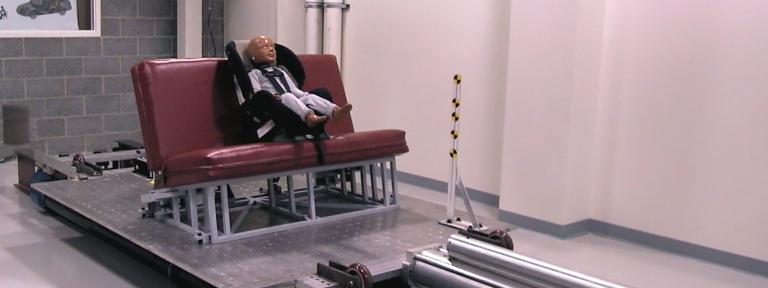
“The Hyundai-Kia tests deal with small occupants ranging from the fifth-percent female crash test dummy (SID-IIs), to the 10 year-old, the 6 year-old and the 3 year-old dummies.”
The Kettering University Crash Safety Center was awarded a research grant from Hyundai-Kia evaluating rear seat, small occupants in side impact crash events.
“Hyundai Kia has been an excellent partner,” said Dr. Janet Brelin-Fornari, professor of Mechanical Engineering and director for the Crash Safety Center.
Ravi Tangirala, senior engineer and technical lead for Safety Integration at Hyundai-Kia Motors in Superior Township, Mich., was on campus in November 2011, to watch some of the testing first-hand and discuss initial findings with Brelin-Fornari and Dr. Massoud Tavakoli, professor of Mechanical Engineering and co- principle investigator on the project with Brelin-Fornari.
Tangirala said Hyundai-Kia funded this research project with Kettering because the Crash Safety Center has a good reputation in safety testing for child restraints and experience working with the National Highway Transportation Safety Administration (NHTSA).
Even though most Hyundai-Kia vehicles have four or five star safety ratings, “We want to better understand what happens to children in accidents, and what we as a company can do better when we design our safety restraints,” said Tangirala.
“Hyundai-Kia is trying to develop more protection for children in side impact crash events, if needed,” said Tavakoli, of the testing. “The Hyundai-Kia tests deal with small occupants ranging from the fifth-percent female crash test dummy (SID-IIs), to the 10 year-old, the 6 year-old and the 3 year-old dummies,” he explained.
Children are currently non-rated in side impact crash testing. Federal Motor Vehicle Safety Standard 213 regulates child restraint systems (child seats) in frontal crash tests only. NHTSA is working to add side impact standards to FMVSS 213, according to Tavakoli.“The side impact standard protocol for child seats that we are evaluating for NHTSA may also be a part of FMVSS 213,” added Brelin-Fornari. “Even if adopted, the child seats will not have to be tested in each model of vehicle,” she said, “but will be evaluated generically.”
“The Hyundai research enables us to evaluate side impact dynamics of small occupants (children and small adults) with the vehicle component parts/environment (instead of generic). In other words, the Hyundai research is allowing us to evaluate the side impact dynamics of the occupant in the vehicle and not the design of the child seat itself,” Brelin-Fornari said.
Hyundai-Kia has a strong interest in what happens to a child in a crash event, according to Tangirala. Working independently of NHTSA but with a similar goal, the company implemented a project in 2010 to understand field data related to what happens to children in side impact crash events. The project Hyundai-Kia has with Kettering is designed to understand lab-created data in comparison with their field-generated data.
“Our first goal was to duplicate the results of a full-scale vehicle side impact test using SID-IIs with a sled test,” said Tavakoli, “then use the sled tests to evaluate the performance of other ATDs (anthropomorphic test devices, in this case child-sized crash dummies) in the same impact.”
“The obvious advantage is that we can run many scenarios readily without smashing full vehicles every time,” added Tavakoli.
“Hyundai-Kia wants to make sure the lab-created data matches the field data, and then continue testing projects for different sized children to compare to the field data from 2010,” explained Tangirala of the Kettering research. “We will use this information to determine if we can improve the safety performance of our vehicles in regard to child passengers.”
“The question we have for Kettering’s Crash Safety Center is ‘can the lab represent the field?’ meaning, can we recreate field results in the lab?” Tangirala said.
In addition to using the information gathered from comparing lab and field data to improve their product, Tangirala said Hyundai-Kia intends to share the findings with agencies outside the company. “We want to share our findings with the world,” he said, “this is part of Hyundai-Kia’s contribution to crash safety.”The Kettering/Hyundai-Kia project started in August 2011. The Kettering test team includes Tavakoli, Brelin-Fornari, Sheryl Janca, research engineer for the Crash Safety Center, Clint Lee, senior academic lab coordinator in Mechanical Engineering, and Dave Cheyne, president of Global Test and Engineering Systems.
For more information about the Kettering University Crash Safety Center, visit /our-research-labs/crash-safety-center or contact Dr. Janet Brelin-Fornari at jfornari@kettering.edu or Dr. Massoud Tavakoli at mtavakol@kettering.edu.